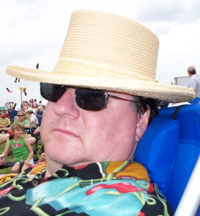Welcome to Social Networking 101! In this series of lessons, we are going to teach you how to establish your presence in the vast world of social networking. Whether you are just starting out, or if you are a social networking maven, we hope to share some unique methods and tools that can save you time and give you a more visible web presence.
If you missed the first three lessons, you might want to go back and read them now.
Why Use a Picture?
A while after Twitter became popular, former Mac Evangelist Guy Kawasaki started a thread about which of his pictures people liked better. It was interesting - even ground-breaking in a way - because Guy was using the power of the micro-blogging service to allow his followers choose what they thought was a better representation for his personal brand.
Why is this important? Because your picture really does say a thousand words about you. When choosing a picture to go with your online persona, it is important your choice reflect the content your brand is intended to represent.
That last sentence was a mouthful. Let's look at it again:
When choosing a picture to go with your online persona, it is important your choice reflect the content your brand is intended to represent.
Simply put, when you assign a picture to your profile on a web site, you should make sure the impression it gives is appropriate for the content of that site. If you are trying to get more clients or provide advice in a blog, that picture of you wearing the Groucho Marx glasses probably isn't appropriate.
Likewise, for a personal blog or on more informal social networking sites, a businesslike pose may betray the more fun aspects of your personality, so maybe a more playful picture is in order.
Choosing the Right Image
Here are some guidelines for choosing just the right picture.
Make sure it is of you, and you alone. People want to see who YOU are. They don't care about Cousin It if they are looking at a page about you.
Use a head shot. If you're hot, there will be plenty of opportunity to post your full body pictures later. If you're not, no one wants to see your entire body anyway. ("Oh look, he's put on 20 pounds since I saw him last.") People want to see your face. Remember, we are talking about social networking here, and absolutely nothing establishes one's social identity better than their face.
Make sure you can crop and resize it. Many web sites have different requirements when it comes to the size of a picture, both in pixels and in file size. So you are going to want to have a hi-res photo you can crop or resize while making sure people can still recognize it's you. (This is why head shots are so important, and another reason why full body and group shots don't work well.)
Use a background that contrasts with your picture. There's a reason professional photographers use backdrops: so they can control the lighting and emphasize the subject. The thing that should stand out is your head. If you have brown hair and were photographed against a brown wall, you won't stand out.
Use proper lighting. If I have to squint to make out your facial features, your picture is too dark. Get a good photo editing program and brighten it up a bit, or better yet, have a professional photographer take your picture. If you really intend on having a web presence, it will be worth it. (BTW, I strongly recommend Pixelmator for image editing. It has all the features most of us will ever need at a fraction of the price for Adobe Photoshop®.)
Use it everywhere. Your picture needs to be as ubiquitous across sites as your user name. When someone sees your user name on a social networking site, they will look at the picture to see if the page belongs to the same person. So if you use different pictures on different sites, your followers might get confused. The one exception to this is when you are establishing both personal and professional brands. For them, it would be appropriate to use two images if you want, but make sure you use them appropriately. A good place to start would be to choose one for linked and another for LinkedIn. (More about that in a minute.)
Make sure it is content appropriate. I can't stress this enough. When choosing a picture to go with your online persona, it is important your choice reflect the content your brand is intended to represent. So much so, in fact, that I am going to give it it's own special section…
What is "Content Appropriate?"
In Lesson One we talked about the possibility of creating both personal and professional brands. If you are looking to establish one identity on the web, then no worries - choose a picture that is "middle of the road." Not too business-looking, but also don't make it look like all you do is goof off.
But if you are interested in building both personal and professional identities on the web, here is where you can really let your personality shine. For instance, I have two distinctly different pictures I use for my online identities:


Pretty easy to tell which one is for professional use and which is for personal use, huh? Heck, some people have even said it doesn't look like the same person. The one on the left was taken by a professional photographer several years ago, and the one on the right was taken by my wife last year at Jazz Fest. But that's OK - I am showing off different aspects of my personality. When you see one of these pictures associated with my profile on a social networking site, you immediately know how I view that site.
Someday I will get another professional head shot done, but until then, the one above will work just fine for my professional web presence.
Using an Avatar
You might notice I have used the word "picture" or "image" throughout this article so far, but the article's name is "Photos and Avatars." Just what is an avatar anyway? While some people call any picture or image used to visually identify a person in a public profile an "avatar," I think that usage is inappropriate. I mean, you are using a photograph, let's just call it a photo, OK?
According to Wikipedia, "An avatar is a computer user's representation of himself/herself or alter ego, whether in the form of a three-dimensional model used in computer games, a two-dimensional icon (picture) used on Internet forums and other communities, or a text construct found on early systems such as MUDs. It is an 'object' representing the embodiment of the user.l The term 'avatar' can also refer to the personality connected with the screen name, or handle, of an Internet user."
For our purposes, I am going to suggest that an avatar is a "stylized" version of the image you want to use, or even a characterization of your personality unrelated to your actual appearance. If you think your photo is not distinctive enough, consider using an avatar to convey your image.
There are several services that will assist you in creating avatars. DoppleMe doesn't even use your photo. You start by choosing whether you are male or female, and then add characteristics to your avatar to make it uniquely yours.
Meeze allows you to create a 3D avatar. The basic stuff is free, although to really dress your avatar up you will need to spend buy what they call "coinz" - the currency of the site.
My favorite, however, is BeFunky, a very well-designed site that allows you to turn any picture into a cartoon or any number of other effects. Here's the avatar I created using my "Chuck at Jazz Fest" picture above:

I like that so much, I just might start changing my personal picture over to it.
Other Uses for an Avatar
If you want to hide your true identity online, but nonetheless build a web brand, an avatar is the perfect way to go. After all, it doesn't have to look like you - you just need to use it consistently on all your profiles.
Consider using an image that says something about you, but can still be uniquely yours. For instance, a custom avatar you create that looks nothing like you might be one way to go, but you could also use your favorite food, the building where you live, or a pet.
If you decide to use a photo, make sure it is one you took yourself, or one that you are sure you can use. Stock.xchng, Stockvault.net, and FreeStockPhotos.com are all great places to find pictures you can use for free. But if you grab one of those, make sure you edit it in some way to make it uniquely yours.
For more information on creating an avatar check out this great article on webupon.com: Get Creative: 10 Fun Websites to Create Your Free Avatar.
Updating Your Picture
Some web sites suggest updating your picture in your online profiles. I've even seen it suggested that you update your picture every 6 months. Before you update, think about the purpose of having your picture there in the first place. Is it so people can recognize you if they see you on the street? If so, it is probably a good idea to keep it updated.
For most of us, however, the picture we choose to associate with our online profiles is more to establish our image, and reinforce our personal or professional branding. If that's the case, then the less you update it, the better.
Of course, if your situation changes in some significant way, and your previous situation is reflected in your avatar or photo, then you should probably change it. If you are using the Seattle Tower in your avatar and you no longer live in Seattle, for instance, it might be a good time to change it.
Avatar and Photo No-Nos
DON'T use full body shots
DON'T use suggestive or provocative pictures unless it is content appropriate for that particular profile.
If you are a woman, DON'T use more makeup for your photo than you would normally. The point is so people will be able to recognize you.
DON'T use photos or artwork belonging to someone else without their permission.
DON'T use "generic" pictures that say nothing about you.
Summary
- Choose a picture that says something about you personally.
- Choose a picture appropriate for the profile(s) to which you are posting.
- Use a different photo for your personal and professional profiles.
- Unless you are trying to hide your true identity online, use a good headshot of yourself.
- Use the same picture EVERYWHERE, in every similar profile.
Assignment: Choose a photo for use when you start creating profiles on social networking sites. (Choose two if you are doing both professional and personal branding.)
Extra Credit: Stylize your picture using BeFunky.com, or create an individual avatar.
Next Lesson: Get a Google Profile.
We are almost done with Social Networking 101, where you learn all the tools you need to brand yourself when establishing your web presence. One more lesson and you graduate to Social Networking 102: The Sites.


